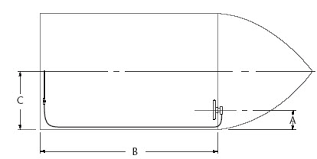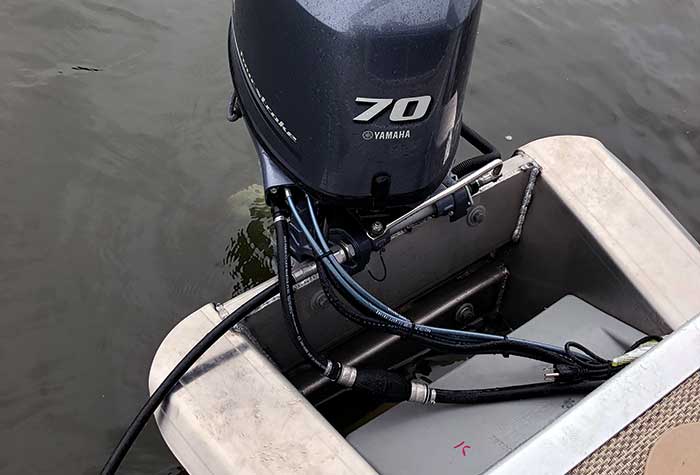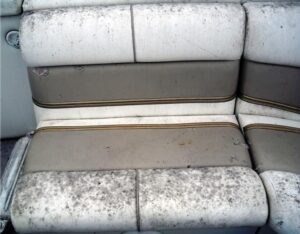After using and traveling with your craft for a while, you might notice that some of the components need to be repaired or that some of the units need to be replaced in accordance with the manufacturer’s recommendations. Thus, one of them is the steering cable for boat wheeling systems.
When measuring steering cables for boats, whether for replacement or new construction, you must be meticulous. It is inevitable as the boat ages and the steering system experiences excessive wear from daily use.
The first step is to try to determine the type of cable from markings edged into the plastic coating; this will give you some idea of both the type and size of the cable. Some cables are measured in feet, while others are measured in meters. The most popular system is the through-the-engine tilt tube system. Steering issues are frequently manifested as sudden stiffness, total locking, and easy one-way turns but difficult one-way turns. If your steering system isn’t regularly inspected and maintained, you could lose all steering functionality.
If you want to know how to measure a steering cable for a boat, please read this article carefully.
What Is A Steering Cable For A Boat?
In almost all types of automobiles, steering systems frequently include cables. In fact, the system is among the most crucial ones in a mobile watercraft. In addition to providing direction and stability to vessels, steering systems also give boar owners a great deal of flexibility and practicality.
On the other hand, the cables used in steering systems to power the boat motor and turn the steering wheel are a crucial component.
Aquatic steering cables are specialized wires used in hydraulic systems for boats and other equipment. They make sure the steering wheel functions properly and glides smoothly while also supplying energy to the system.
The types of steering systems and steering cable models are as varied as the steering systems themselves. But when it comes to the best steering cables for boats, Ultraflex and Teleflex are the two most suggested.
How To Measure A Steering Cable For A Boat?
Identify The Type Of Steering Cable For Your Boat
Typically, there are three types of steering systems. Rotating and rack-and-pinion steering are two types of mechanical steering. Hydraulic boat cables come in third. Each boat has a specific cable length that is adjusted to the boat’s dimensions.
Rack-and-pinion and rotary steering cables come in a variety of designs. The type, size, and horsepower of the engine all affect the variations. The type of steering cable depends on the boat’s top speed limit and power steering capabilities.
Major brand SeaStar Solutions, formerly Teleflex Marine, is now owned by Dometic. Morse Controls was purchased by Teleflex. On the steering cable of your boat, you might find the logos of any of these companies.
There are a ton of online cross-reference resources because these brand names are being phased out. Ask any marine store’s retail staff for assistance in locating and cross-referencing the brand’s distinctive hot stamp.
An innovative steering design is the Teleflex patented no feedback (NFB) steering, which is now owned by Dometic. Prior to NFB steering, mechanical steering systems constantly tried to right themselves by shifting the steering weight back to the operator when turning. The NFB feature, tilt lift, and extreme cable improve the performance of the boat.
Check The Hot-stamped Identification Number
Because boaters frequently don’t know how to identify the right steering cable by the product number, the steering cable is the one that is returned to marine part stores the most.
Each steering cable’s cable jacketing bears a hot-stamped identification number. Cable jackets are the outer, dark layer of the cable that insulates and shields the conductor core from the outside world.

The required steering cable length can be calculated using the serial number imprinted on the cable jacketing. On the cable’s engine end is the manufacturer’s product number.
For instance, the letter combination at the beginning of the SeaStar Solutions product number SSC6316 indicates the type of brand it is (SSC- SeaStar Cable). The series is illustrated by the next two numbers, and 16 represents the length in feet.
The last three numbers on a Morse cable represent the length of the cable in inches. The more established steering cable brands are Morse and Teleflex. Morse mechanical steering systems are typically found on 35-foot boats.
You will need to measure the cable with a tape measure if the identification number on the steering cases has frequently worn off over time and is no longer present. There is a formula to use in order to ensure accurate measurement.
Measure Both The Cable And The Boat
Thoroughness is necessary when measuring a boat steering cable. The steering cable on a boat will typically lose value over time. Therefore, replacing it is a necessary component of its life cycle. Watch out for corrosion, cuts, and cracks in the steering cables.
Frequently Dometic and SeaStar promote the expression- “Order once, measure twice.” Any boating experience requires a good steering cable.
Use a tape measure to first measure the steering cable, then use the appropriate formula for that cable type and manufacturer. To ensure the precise length, measure the boat’s dimensions second. A cable that is either too much or too little would make steering difficult.
Just one-time ordering and buying the right cable Three times a year is the recommended inspection frequency for cables that need to be maintained, followed by the appropriate care.
Measuring The Boat Steering Cable
People frequently measure their steering cables incorrectly from one end to the next. Saving time and money comes from learning the formula and the proper measurement methods. The three distinct types of cables each have a different formula.
On the rotary and rack-and-pinion steering cables, only the plastic jacket cable should be measured. The formula below will determine the precise steering cable length once you have the measurement.
Calculating rotary steering cable requires multiplying the length of the plastic jacket by 18 inches. After that, round the result of this formula up to the next foot. A rack-and-pinion steering cable is calculated by multiplying the length of the plastic jacket by 30 inches. Round it up to the next foot using the following formula.
The hydraulic jet boat steering cable formula takes into account distances between edges. Round the result up to the next foot using this formula plus the length measurement. For small boats, use the hydraulic jet formula. A surplus bend radius and wasteful cable backlash will be produced by excessive cable length. In conclusion, don’t use more cable than is necessary.
Measuring The Boat’s Dimensions For A Steering Cable
A crucial aspect of boating and steering is taking the proper measurements to install the steering cable. It’s crucial to lay the cable in the straightest path possible because bending interferes with its ability to function.
As long as you adhere to the formula for the boat’s dimensions, replacing your steering cable is straightforward. The length of the cable can be accurately determined by measuring it in accordance with the dimensions of your boat. The steps in the process are listed below.
Use the formula created by the boat’s dimensions to install a new steering system on a sterndrive. A, B, and C are the three sections you should divide the vessel into.
The horizontal measurement A is made with the boat driver facing forward and is the distance between the helm’s centerline and the gunwale. The length along the gunwale is measured using B. It spans the gunwale’s entire length until it intersects the transom. C is the distance along the transom and gunwale from the intersection to the centerline of the boat.
The required base for the steering cable measurement is obtained by adding A, B, and C. For each 90-degree bend in the cable, subtract 4 inches from the sum of the A + B + C equation.
Subtract 6 inches from formulas for installations that are attached to the transom. The engine tilt tube fittings add 6 inches to the length. Round to the following foot using the total of your computations. For an outboard-powered boat, use the same measurement formula but add 6 inches to each A, B, and C.
Ensure Regular Maintenance And Care Of The Steering Cable

A steering cable needs to be maintained, and this calls for at least three times-yearly inspections, cleanings, and care. The main causes of rigid steering and, in some cases, cable seizure are salt, dirt, and corrosion.
Apply marine-grade, lithium-based grease liberally throughout the tilt tube to the cable fittings to lubricate them against corrosion. Remove the tilt tube’s tilt cable telescopic output ram. Clean the area inside the diameter completely by raising the tilt tube. Scrub the area with a brass wire scrub until it’s clean.
Make sure the steering wheel, cable, and other components of the steering cable are securely fastened and have the ability to operate as intended before reassembling the various parts. Check for bending, excess, slack bindings, or free movement of parts.
Avoid using non-locking fasteners where locking fasteners are intended because the vibration from the boat will cause the bindings to come undone and interfere with steering.
Take the steering cable out, clean it, and lubricate it before the long-term storage of your boat to ensure its durability. Make sure you have enough steering so you don’t end up on open water.
Some Tips For Measuring Steering Cable For Boats Appropriately
It is probably preferable to replace the steering cable when operating a watercraft with mechanical steering if there is excessive movement or friction. Even a DIY beginner can successfully complete this straightforward task. Here are some suggestions to make sure your new steering cables are simple to install:
- Replace your steering cable with one that is identical to the original: hydraulic with hydraulic or rotary with rotary. By using this method, you can be sure that your boat will continue to operate as well as the first time you used it for a commute on the water.
- Look at the headpiece and cable jacket’s manufacturing specifications. The type of cable you require will be indicated by those signs.
- It is not possible to buy mechanical steering parts separately. For the sake of safety, these components must all be changed together.
When Should You Replace The Steering Cable for Boats?
If you want to steer clear of problems while out on the lake, it’s essential to regularly inspect your mechanical steering system. It is sufficient to check the steering gears twice or three times a year to make sure your steering system is in top working condition.
Since steering parts are frequently used moving parts, frequent wear and tear are to be expected. You should check the hardware at both the steering helm and the motor ends for damage, corrosion, oxidation, and other issues.
Look closely for any corrosion, rips, cuts, or cracks in the cable jacket. The most likely places for damage to occur are at the crimped endpoints of the cable. In actuality, steering cables cannot be repaired; they must always be replaced when they break. A cable that is very difficult to move needs to be replaced right away because it might be unsafe.
Conclusion
For both specific implementation and replacement, steering cable measurement is needed. We strongly advise boaters to pay close attention to this particular boat component because, if neglected, it could lead to issues.
The formulas to use when measuring the steering cable on your boat with a tape measure depends on the type of cable. The same holds true when taking your boat’s measurements. Regularly inspecting your boat for cuts, cracks, and corrosion is essential to maintaining consistent care for your boat.



